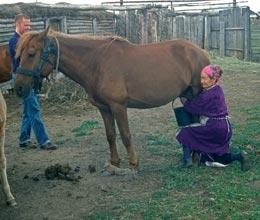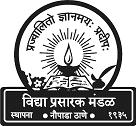|
||||||||||||||||||||
Evidence for ancient horse
ranch uncovered
Traces of earliest known milking of horses in Kazakhstan.

Roberta Kwok
Mares are still milked some parts of Kazakhstan.A Outram
Humans rode and milked horses as early as 3500 BC, say an international group
of researchers. The findings come from ancient settlements in Kazakhstan,
where horse jawbones showed signs of bridling and ceramic cooking vessels
contained traces of horse milk. Researchers also found that the horses' leg
bones resembled those of domestic rather than wild horses.
The discovery of horse milk is "just amazing", says David Anthony, an archaeologist at Hartwick College in Oneonta, New York. Combined with previous findings that people discarded horse manure at those sites, he says, it "is pretty unequivocal evidence for domestication".
Scientists have long debated when humans first domesticated horses. Indirect clues, such as horse bones buried with other domesticated animals in human graves, go as far back as 4500 BC. Horses also show shifts in body size range from around 2500 BC, but the changes are not as dramatic as those in other domesticated animals. More definitive evidence emerges at roughly 2000 BC, when horses were buried with chariots.
Settlements of the Botai culture in northern Kazakhstan, dated around 3500 BC, have attracted attention because they contain masses of discarded horse bones that far outnumber remains from other animals, as well as tools that may have been used for processing hides. But some scientists have argued that the mix of ages among the killed horses suggests the Botai were hunting wild herds rather than raising and slaughtering their own horses.
Demonstrating domestication
Alan Outram, an archaeologist at the University of Exeter, UK, and his colleagues
took a three-pronged approach to investigate the possibility of Botai horse
domestication. First, they looked at the lower leg bones of Botai horses,
and found that they were more slender than the bones of Palaeolithic Siberian
wild horses. Instead, the bones resembled those of Bronze Age domestic horses
and modern domestic Mongolian horses. Studying the teeth and jawbones of the
horses, they also detected tooth wear and extra jawbone growth, suggesting
the animals' mouths had been damaged by bridling. Finally, the team analysed
the hydrogen isotope ratios of fat residue in pottery shards and found two
distinct signatures that seemed to correspond to horse carcass fat and mare's
milk.
"We've not just got domestic horses — we've got domestic horses that seem to have been ridden and milked," says Outram. The findings appear in Science1.
The study suggests the Botai culture was a distinct centre of domestication, separate from the 'Fertile Crescent' area, between the Mediterranean Sea and the Gulf, where cattle, sheep and goats were first domesticated, says Outram. The findings are unusual, he says, because animal domestication typically occurs in cultures that have adopted agriculture, whereas the Botai were hunter-gatherers.
Further back in time
Although the milk evidence is convincing, the leg bone and bridling analyses
are less definitive, says Anthony. Horses naturally vary in size across different
regions, he says, so the leg differences may not necessarily be due to domestication.
Anthony also notes that the methods used to analyse tooth and jaw damage are
preliminary and will need to be confirmed by others.
It is possible that horses were domesticated even earlier than 3500 BC, says Carles Vilà, an evolutionary biologist at the Spanish National Research Council's Doñana Biological Station in Seville. "The study is showing that by that time, [the horses] were already modified," he says.
Outram's team plans to perform further excavations on Botai sites to look for features related to corrals. They may also investigate sites in Russia to look for earlier evidence of horse domestication.
References
Outram, A. K. et al. Science 323, 1332–1335 (2009). | Article
| ChemPort
|




